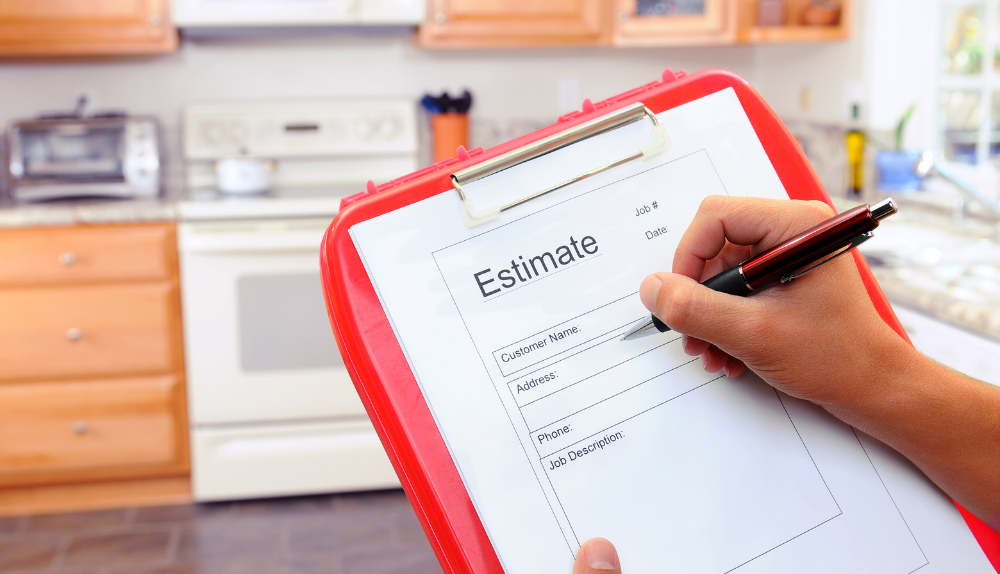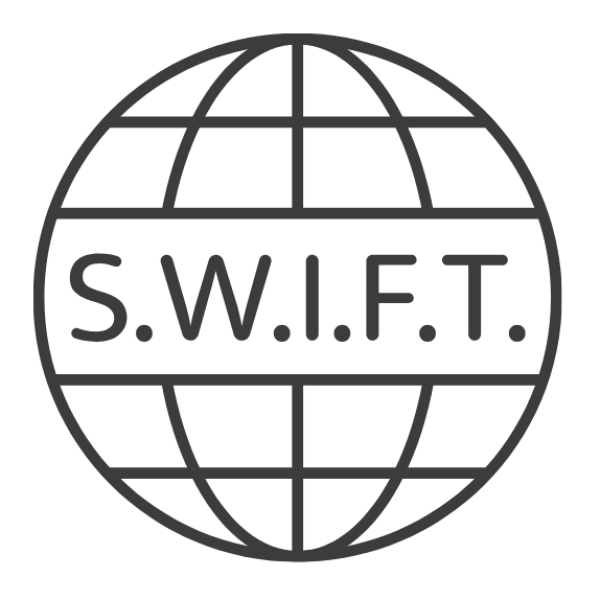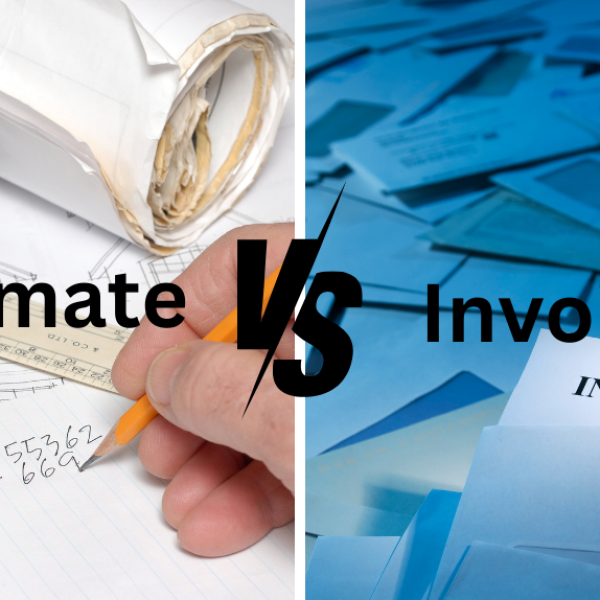An estimate provides a preliminary approximation of costs before fully defining the scope and timelines in the life of a contractor. Conversely, invoices present precise charges after all work is completed, serving as detailed financial statements issued to the company or individual who commissioned the work.
While estimates rely on educated guesses, invoices reflect the exact value of services rendered. This explanation merely scratches the surface of these concepts. Our article will explore more thoroughly Estimate V/s Invoice and detail the key differences between them, their specific uses, and guidelines for their application.
In This Article
ToggleUnderstanding the Purchase Process
The purchase process for small businesses typically unfolds through several key steps. Initially, the process starts when a client seeking specific goods or services initiates a search and contacts your business. You can provide a preliminary estimate detailing the cost, supply time, and other necessary resources. Once a reasonable estimate is agreed upon, the delivery of products or services occurs within the established timeframe.
Following this, the client usually issues a purchase order to confirm the requirements and costs of the ordered goods or services. Commercial invoices are then generated only after the acceptance of these purchase orders. Subsequently, your company can invoice the client for the exact amount. Once payment is received, the final bill is sent to the client, completing the transaction.
What is an Estimate?

An estimate is essentially a calculated approximation of the potential cost of a product or service for a customer. This document typically provides a detailed breakdown of the expenses through line items, showing what each component contributes to the total price and total and billing information. Issuing an estimate doesn’t obligate the customer in any way; it’s primarily a tool for aiding customers in making well-informed decisions and for businesses to map out the specifics of potential projects or tasks.
Additionally, estimates may outline the terms and conditions of the project, provide timelines, and include other relevant details. Such transparency is beneficial for both the business and its clients. It enables clients to gauge the financial implications of a project and determine their interest in proceeding. For businesses, crafting estimates is crucial for organizing schedules and budgeting for upcoming ventures. This practice is commonplace across various sectors, such as software engineering and construction, making skills in estimate preparation valuable for professional development.
What is an Invoice?

An invoice is a document that itemizes and records the costs for goods or services. It acts as a formal notification that the terms of an agreement have been fulfilled, prompting the customer to make payment for those goods or services.
Understanding an invoice in the context of business operations involves examining its role within the accounting process. Accountants use invoices to monitor outstanding payments owed to the business and anticipate when these payments will be received. Invoices are crucial for keeping accurate financial records, facilitating audit processes, and ensuring compliance with regulatory standards.
Invoices serve multiple functions in a business setting, including:
- Prompting clients for prompt payment,
- Tracking sales transactions,
- Managing inventory for product-based businesses,
- Utilizing past sales data to predict future trends,
- Documenting revenue for tax reporting purposes.
Estimate V/s Invoice – Major Differences To Know
Understanding the difference between an invoice and an estimate can be puzzling, especially if both documents list similar line items and amounts. The key distinction lies in their financial implications: an invoice is a binding document that demands payment from the customer for services rendered or goods received. The total specified on the invoice represents an amount that the customer is legally obligated to pay.
Conversely, an estimate is more of a preliminary document provided to customers to offer an idea of what a product or service might cost before any formal commitment to purchase is made. It helps customers decide whether to proceed with a transaction by showing potential costs. Once a customer chooses to move forward based on an estimate, an invoice is issued as an official request for payment, reflecting the agreed-upon prices for the items listed.
Here is a brief overview:
| Aspect | Estimate | Invoice |
| Definition | An estimate is a detailed document predicting the approximate charge for goods or services offered to a client. | An invoice details the products or services provided, the total amount owed, and the payment method. |
| Purpose | Provides an approximate cost, subject to changes based on further discussions. | Issued after the completion of a project or delivery of goods/services to request payment. |
| Nature of Cost | Offers some flexibility; discounts for early payments or penalties for late fees may apply. | Specifies a fixed cost reflecting all project data; considered a final bill. |
| Flexibility | Allows for adjustments post-discussion, may lead to revised estimates. | Typically, it is non-negotiable, but terms like payment schedules or early payment incentives can be discussed. |
| Timing | Offered before engaging in formal agreements or starting a project to help clients anticipate costs. | Prepared and sent after project completion or service delivery to finalize the transaction. |
| Negotiability | Initial costs can be negotiated and adjusted, aiding in financial planning for the client. | Adjustments are made through issuing credit or debit notes if changes are necessary after billing. |
| Revision Possibility | Adjustments are made through issuing credit or debit notes if changes are necessary after billing. | Adjustments made through issuing credit or debit notes if changes are necessary after billing. |
Types of Estimates

Having grasped the fundamental concept of an estimate, let’s explore the various types of estimates that experts typically categorize into four main types:
- Preliminary Estimate: This is a basic assessment of a project’s overall cost and scope, often based on data from similar past projects.
- Detailed Estimate: As the name suggests, this provides a comprehensive breakdown of every aspect of a project. It includes detailed information on all items and services, specifying quantities, costs, rates, and fees.
- Quote: This is a specific statement of the prices for products and services a business can offer. It’s commonly formatted as a quote template that encapsulates all the crucial details, making it very practical for client presentations.
- Cost Estimate: This is an in-depth evaluation of all expected costs associated with a project, but it typically does not include a timeline.
Other specialized estimates may also be employed depending on various project-specific factors. All these types of estimates are interconnected as they are provided to clients before any work commences, helping them understand the terms and conditions of the forecast. They can be tailored to suit the client’s specific requirements. Work typically begins once approval is received from the customer.
Critical Components of an Estimate
When drafting an estimate, it is crucial to incorporate several essential elements to ensure it is clear and compelling. These elements include:
- Services and Goods Provided: Thoroughly describe each service or good offered so the client understands precisely what they are evaluating.
- Costs: Present a detailed, itemized list of all charges, specifying the expenses for materials, labor, and other costs associated with the services or goods provided.
- Client and Supplier Information: Include comprehensive details for both the supplier and the client, such as names, addresses, and contact information, to identify all parties involved clearly.
- Date and Estimate Number: Ensure each estimate is dated and assigned a unique estimate number for easy tracking and future reference.
- Project Scope and Exclusions: Clearly define the scope, specifying what is included and noting any exclusions to avoid misunderstandings.
- Timeline and Completion Date: Provide an estimated timeline and a projected completion date for the project, which will help set expectations and plan.
- Payment Terms and Conditions: Outline the payment terms, including details on upfront payments, installments, and the terms for final payment, to manage financial expectations and agreements.
Types of Invoices
When it comes to accounting, entrepreneurs use various invoice types, each serving the fundamental purpose of confirming the completion of an order and facilitating payment collection. The range of invoice types is extensive, more so than estimates, including:
- Standard Invoice: This is the most prevalent type of invoice, incorporating all the essential details previously outlined. It serves as a comprehensive request for payment under standard business transactions.
- Commercial Invoice: Commercial invoices are necessary for customs clearance. They are used primarily for international transactions and must include the total value of the product, a detailed description, information about the parties involved in the sale, the country of origin and destination, and the shipment’s weight.
- Final Invoice: Final invoices are issued to request payment for large projects that span extended periods and involve multiple phases. They are sent upon the completion of a project and summarise all costs and work done.
- Interim Invoice: Interim invoices facilitate payment for long-term, multi-stage projects by allowing businesses to receive partial payments as different project stages are completed rather than waiting for a single payment at the project’s end.
- Recurring Invoice: Similar to interim invoices in their periodic nature, recurring invoices are set up in advance to bill for ongoing services at regular intervals. This ensures consistent billing for continuous work without requiring manual invoice generation each time.
While the basic function of all these invoices is to secure payment, the specifics of each can vary. For example, a credit memo containing essential details about the customer’s account balance would be issued for returns or refunds. Tools like Blinksale Online Invoicing can streamline and automate the invoicing process.
Critical Components of an Invoice
An invoice typically comprises several essential elements that detail the specifics of the transaction. Here are the primary components commonly found in an invoice:
- Date: This is the date the invoice is issued and is crucial for determining the payment due date. For instance, if the payment terms are “net 30 days,” the payment is due 30 days from this date.
- Invoice Number: Each invoice carries a unique number as an identifier. This is critical for maintaining records and allows the seller and buyer to track the payment and reference the transaction in future communications.
- Customer Information: This includes essential details such as the buyer’s address, name, and contact information, mirroring the vendor information.
- Vendor Information: This section details the seller’s or service provider’s name, address, contact information, and sometimes the tax identification number.
- Subtotal: Represents the aggregate cost of all goods or services before any taxes, discounts, or additional fees are added.
- Description of the Services: This invoice section includes a thorough description of the goods or services rendered, quantities, unit costs, and line item totals. The buyer should understand what they are being billed for with sufficient clarity.
- Total Amount Due: This is the complete amount the buyer must pay. It is calculated by adding all charges, including taxes and additional fees, to the subtotal and subtracting any discounts.
- Payment Terms: This specifies the agreed-upon terms for payment, such as the due date and preferred payment methods. It might also include penalties for late payment.
- Taxes, Discounts, and Additional Fees: If applicable, these are listed separately on the invoice, detailing any taxes, discounts (e.g., for early payment), and additional charges (such as shipping or handling). Each is itemized and adjusted against the subtotal accordingly.
- Notes: Some invoices feature a notes section where sellers can include extra details relevant to the transaction or a personalized message to the buyer.
While these components are typical, they can vary depending on the nature of the business, the complexity of the transaction, and local business practices or regulatory requirements. However, these elements are generally standard across most invoices.
How do you convert an estimate into an invoice?
To transform an estimate into an invoice, you’ll need to update an estimate with more precise values and additional elements typical of invoices.
For example, estimates often lack specific details, such as the completion date of the service or product delivery and the detailed breakdown of line items, including purchase units. These will need to be included in your invoice. Additionally, tax information, which is not usually part of an estimate, must be calculated and added.
Many accounting or invoicing software programs offer a feature to convert estimates into invoices easily. By selecting the “Convert to invoice” option, you can input these necessary details, converting your estimate into a comprehensive invoice ready for billing.
Tips & Best Practices for Providing Estimates and Invoices
- Embrace Simplicity: Choose an efficient system and stick with it. Utilize user-friendly online software that offers templates to streamline your documentation process. Keeping all your information in one centralized location minimizes errors. Ensure that everything on your documents is organized and straightforward to prevent confusion.
- Personalize Your Invoices: Customizing your invoices can help identify them quickly and foster a stronger connection with your clients. Include a thank you note for their business, and consider addressing them using the contact person’s first name in the project.
- Enhance Your Brand Identity: Use your estimates and invoices as tools to strengthen your brand. Include your company logo on both documents to set them apart from competitors and reinforce brand recognition.
- Clarify Your Work Descriptions: Make sure that the descriptions of your services or products are concise yet comprehensive. This clarity helps clients understand exactly what they are being billed for, enhancing transparency and trust.
Conclusion
The distinction between estimates and invoices lies in their timing, purpose, and financial implications. While estimates offer a preliminary approximation of costs before formal agreements are made, invoices represent precise charges for services rendered or goods provided, serving as formal requests for payment. Understanding the purchase process, the types of estimates and invoices, and their key components is essential for effective financial management and client communication in business operations.
By adhering to best practices, such as embracing simplicity, personalizing invoices, enhancing brand identity, and clarifying work descriptions, businesses can streamline documentation processes and foster stronger client relationships. Converting estimates into invoices involves updating details to reflect the finalized costs and additional invoice elements, which can be easily achieved through accounting or invoicing software.
Ultimately, mastering the art of providing accurate estimates and clear invoices is crucial for financial transparency, effective client communication, and the overall success of business transactions.
Frequently Asked Questions
What is an estimate?
An estimate is a preliminary document outlining projected costs for a service or product before starting a project. It provides a rough idea of financial commitments, which are subject to change.
What is an invoice?
An invoice is a formal request for payment issued after services or goods delivery. It details the actual costs incurred and represents a binding demand for payment.
Why do both estimates and invoices include similar line items?
While both may list similar costs, estimates aid planning without requiring payment, while invoices demand payment post-service. Similarity ensures consistency and clarity, serving different purposes for providers and clients.
How do estimates benefit the business-client relationship?
Estimates establish transparency, setting clear expectations for clients and aiding informed decisions. They help assess project viability and resource planning, fostering a robust business-client relationship.











